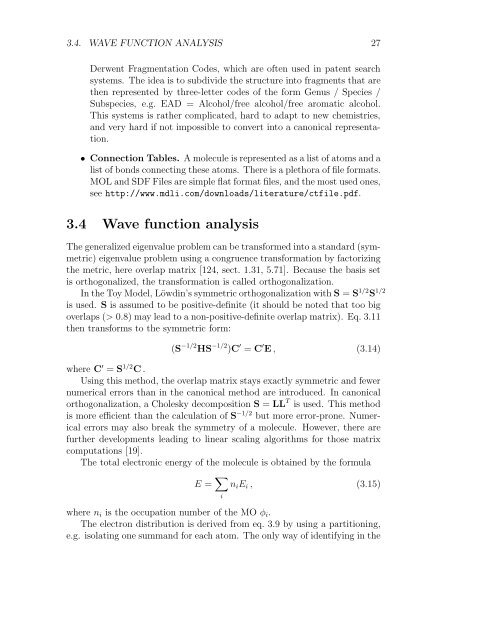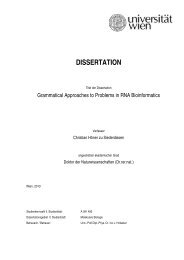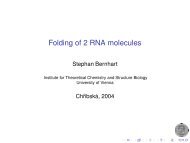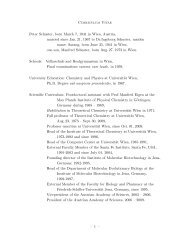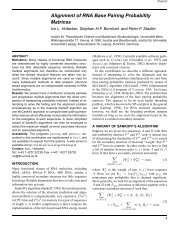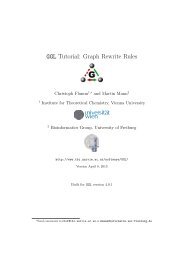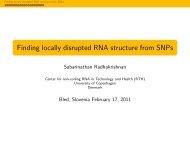A Toy Model of Chemical Reaction Networks - TBI - Universität Wien
A Toy Model of Chemical Reaction Networks - TBI - Universität Wien
A Toy Model of Chemical Reaction Networks - TBI - Universität Wien
Create successful ePaper yourself
Turn your PDF publications into a flip-book with our unique Google optimized e-Paper software.
3.4. WAVE FUNCTION ANALYSIS 27<br />
Derwent Fragmentation Codes, which are <strong>of</strong>ten used in patent search<br />
systems. The idea is to subdivide the structure into fragments that are<br />
then represented by three-letter codes <strong>of</strong> the form Genus / Species /<br />
Subspecies, e.g. EAD = Alcohol/free alcohol/free aromatic alcohol.<br />
This systems is rather complicated, hard to adapt to new chemistries,<br />
and very hard if not impossible to convert into a canonical representation.<br />
• Connection Tables. A molecule is represented as a list <strong>of</strong> atoms and a<br />
list <strong>of</strong> bonds connecting these atoms. There is a plethora <strong>of</strong> file formats.<br />
MOL and SDF Files are simple flat format files, and the most used ones,<br />
see http://www.mdli.com/downloads/literature/ctfile.pdf.<br />
3.4 Wave function analysis<br />
The generalized eigenvalue problem can be transformed into a standard (symmetric)<br />
eigenvalue problem using a congruence transformation by factorizing<br />
the metric, here overlap matrix [124, sect. 1.31, 5.71]. Because the basis set<br />
is orthogonalized, the transformation is called orthogonalization.<br />
In the <strong>Toy</strong> <strong>Model</strong>, Löwdin’s symmetric orthogonalization with S = S 1/2 S 1/2<br />
is used. S is assumed to be positive-definite (it should be noted that too big<br />
overlaps (> 0.8) may lead to a non-positive-definite overlap matrix). Eq. 3.11<br />
then transforms to the symmetric form:<br />
(S −1/2 HS −1/2 )C ′ = C ′ E, (3.14)<br />
where C ′ = S 1/2 C.<br />
Using this method, the overlap matrix stays exactly symmetric and fewer<br />
numerical errors than in the canonical method are introduced. In canonical<br />
orthogonalization, a Cholesky decomposition S = LL T is used. This method<br />
is more efficient than the calculation <strong>of</strong> S −1/2 but more error-prone. Numerical<br />
errors may also break the symmetry <strong>of</strong> a molecule. However, there are<br />
further developments leading to linear scaling algorithms for those matrix<br />
computations [19].<br />
The total electronic energy <strong>of</strong> the molecule is obtained by the formula<br />
E = ∑ i<br />
n i E i , (3.15)<br />
where n i is the occupation number <strong>of</strong> the MO φ i .<br />
The electron distribution is derived from eq. 3.9 by using a partitioning,<br />
e.g. isolating one summand for each atom. The only way <strong>of</strong> identifying in the


